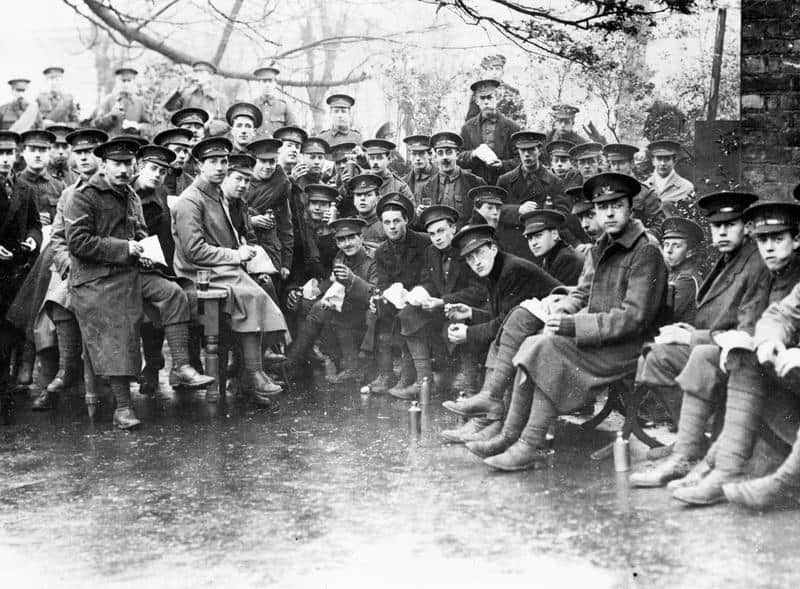Wartime on Hampstead Heath.
Throughout both wars, the Heath was used by local soldiers for training and exercise, and the earth dug for trenches, sandbags and allotments. This is our wartime story.
9th London Regiment, Queen Victoria's Rifles training on Hampstead Heath, December 1914
9th London Regiment, Queen Victoria Rifles Training around Hampstead, 1914
world war i
The Hampstead Howitzers (183rd Royal Field Artillery), the Hampstead Heavies (138th Heavy Battery, Royal Garrison Artillery), 9th Battalion (County of London) Queen Victoria’s Rifles and the Royal Engineers (Signal Service) all trained here during WWI. They were made up of local men and many of them, particularly the Hampstead Heavies, went on to serve in France and Belgium. Most of those who died in battle were buried on the battlefield, but six were transported home before they died and buried locally. Other local people had different roles in the war. The Carline brothers who lived at 47 Downshire Hill became official war artists, designing medals and painting aerial views, while local Percy Smith sketched the horrors of war in France and Belgium, particularly the Somme, where he was stationed as a gunner with the Royal Marines.
March drill, 1916
9th London Regiment, Queen Victoria's Rifles on Heath, December 1914
WWI recruiting office at Hampstead Heath, 1910
A military hospital was set up at Kenwood House during the First World War, staffed by trained nurses and volunteers, at the suggestion of the Grand Duke Michael Michaelovitch of Russia (who leased it at the time) and Lord Mansfield. Other military hospitals in the area included New End Hospital (which started life in 1850 as the Hampstead Workhouse), Rosslyn Lodge military auxiliary hospital, and Mount Vernon. When London began to be bombed, weapons systems were placed at the highest points on Hampstead Heath. Anti-aircraft guns were also stationed at the rear of Kenwood House and beside Whitestone Pond. The Great Eastern Railway built a platform at Gospel Oak, which was used in both World Wars to transport troops across the south of England. The line was bombed heavily by the Germans.
Trench digging practice on Hampstead Heath, Queen's Westminsters, 1915
Artists Rifles training on Hampstead Heath, 1914
After German submarine blockades reduced food imports and rationing was introduced in 1918, allotments were opened on the Heath - near Gospel Oak Station on the King’s Meadow, near the Vale of Health Pond (known as ‘Soldiers’ Allotments’), on the slopes facing Highgate and on the Heath Extension. Sand was also dug up for sandbags. At this time, local councils opened National Kitchens, which served low cost meals in exchange for tokens. The Central Baths on Finchley Road was the main cooking site in the Hampstead area.
Hampstead mothers demand nurseries for their children so they can work for the war effort, circa 1942
Women fill sandbags at West End Green, September 1939
World War II
The Second World War was arguably harder on the Heath and the local people. The War brought heavy bombing to London, and Hampstead and Belsize Park tube stations were used as air-raid shelters. These are very deep stations (Hampstead’s is the deepest in London) and offered more protection - and quiet - than the house basements and Anderson Shelters that many Londoners relied on. As the nightly air raids became more frequent, some people virtually took up residence in the shelters, tired of having to get up several times each night. Some people even slept out in the open, on the Heath itself, to escape the bombings in the city, though the Heath wasn’t spared – a bomb near the playground severely damaged houses in Savernake Road and Estelle Road, and Mansfield Road School was completely destroyed by a bomb in 1944. Roads that suffered damage and casualties included Broadhurst Gardens, Ardwick Road, Mortimer Crescent, Inverson Road, Fordwych Road, and many others. A ‘doodlebug’ once landed in one of the Heath’s ponds near Parliament Hill, and the explosion caused significant damage.
Bomb damage in Hampstead by the end of the Second World War, 1945
Hampstead and Highgate had no military significance, but it suffered nonetheless. In total, 467 high explosive bombs and incendiary bombs fell on Hampstead, leading to 1,134 casualties (200 of them fatal), 13,500 damaged homes and leaving 3,000 people homeless. Among the most heart-breaking stories is that of a party of 11 men, women and children who were in a flat over a butcher’s shop in West End Lane (west of Hampstead) celebrating a wedding when a bomb hit the building; the only survivor was father of the groom. The longest raid on the area lasted ten hours and 15 minutes.
Other notable local buildings that were destroyed or damaged by the bombs were the Golder’s Hill Mansion and the old pub Jack Straw’s Castle, fortunately after closing time. Gospel Oak School now stands on the site of the ill-fated Mansfield Road School. Again, through the war, RAF barrage balloons and anti-aircraft batteries occupied parts of the Heath, and sand quarries were dug to fill sandbags. Allotments appeared again, and emergency water tanks were built on the Heath to help fight fires.
The fairs continued during the war, providing some entertainment, though they were affected by blackout restrictions and limited supplies of food, fuel and ‘swag’. Music was also muted in case it drowned out the sirens. Entertainment that doubled as fundraising for the war effort was very popular, often featuring servicemen themselves, such as boxing tournaments.
Women and children settling in for the night in Belsize Park station, Henry Moore, 1940










